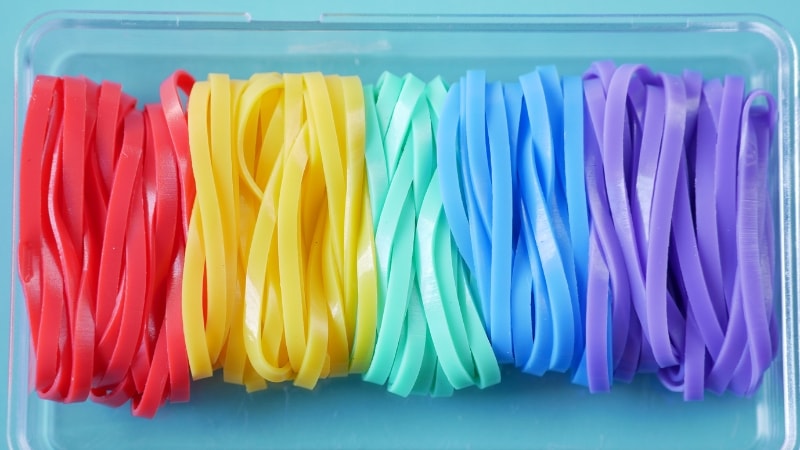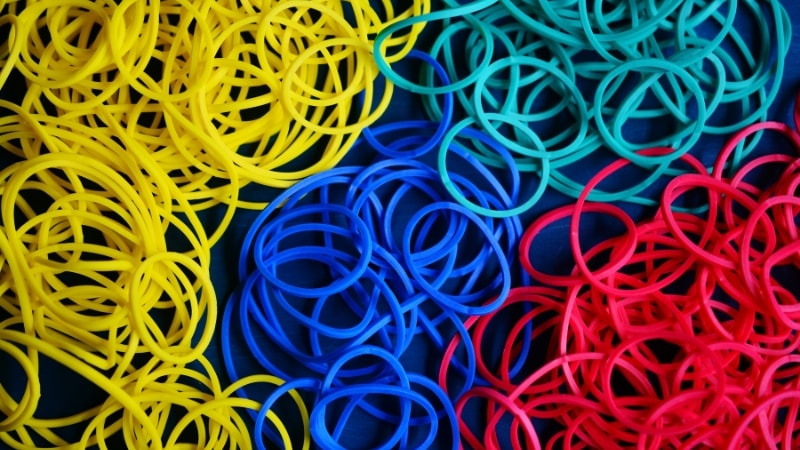Have you ever questioned yourself why the rubber that you see is mostly black? Or does rubber at all come in different colors? Rubber is such a fantastic material and is found in everything, your car tires, shoes, and even in small seals inside your machines. Let’s explore the natural color of rubber, different colors of rubber, and why black is so dominant.
What Is the Natural Color of Rubber?
The normal color of rubber, that is, of Natural rubber, is milky white. It resembles milk when harvested, and it is picked directly from rubber trees as a liquid latex. The liquid is a very complex blend of rubber particles, water, and other natural substances.
When this latex is coagulated and dried in the absence of additives, it behaves as a solid, translucent, and yellowish-brown compound. This raw, natural rubber is not jet black. Its clear, somewhat yellowish hue is its native original color.

This artificial hue is not common in everyday commodities. The reason is that raw rubber is normally further processed. There are a lot of materials added to it to enhance its chemical properties. These additions usually alter its looks too much.
Why Is Most Rubber Black?
The widespread use of black rubber is not by chance. It is because a particular component has been added during the manufacturing process. It is carbon black. Carbon black is fine and powdery. It is produced through burning petroleum products in an enclosed atmosphere of restricted oxygen.
The addition of carbon black to rubber has a number of important reasons:
| Benefit | How Carbon Black Helps | Example |
|---|---|---|
| Strength & Wear Resistance | Reinforces rubber structure, making it stronger and longer-lasting. | Car tires, conveyor belts |
| UV Protection | Absorbs harmful UV rays, preventing cracking and brittleness. | Outdoor seals, gaskets |
| Heat Dissipation | Helps release heat during use, reducing thermal damage. | High-speed tires |
| Cost Efficiency | Widely available and affordable compared to other additives. | Mass-produced industrial products |

How Is Rubber Colored During Manufacturing?
The coloring of rubber is a precise process. The rubber compound is powdered, and manufacturers add pigments or dyes to it during the mixing process. This occurs prior to the molding or shaping of the rubber. The colouring process may vary slightly in the case of artificial rubber and natural rubber.

- Natural Rubber
A good natural rubber originates as a yellowish-white substance. A greater quantity of pigment may be required in order to obtain bright, vivid tints.
And the reason is that the natural color will fade the color of the finish somewhat. Natural rubber, however, takes in pigments well. It is capable of producing a variety of colors.
- Synthetic Rubber
Synthetic rubber is basically an artificial rubber material built chemically. They are usually clear or off white in origin. This makes it easier to color. The raw material tends to be more regular in color. This implies that a weaker pigment may have to be used to make a particular shade.
Various pigments may also react differently with different kinds of synthetic rubber (such as silicone, EPDM, or Neoprene). Naturally, silicone and some synthetic rubbers are translucent. This gives a very clear or bright colored product.
Colored Rubber: Functional or Aesthetic?
Colored rubber is used as a functional and aesthetic piece. In some cases, the color is selected only because it looks good. In other cases, it involves safety or certain performance requirements. Color coding is very common in the industrial setting. It is useful in terms of safety, identification, and compliance.

1. Red
Red rubber would usually mean warning or danger signs. As an example, fire hoses, emergency stop buttons, or high-pressure lines may be red. It is an eye-catching color.
2. Yellow
Another safety color is yellow. It frequently indicates warnings or dangers. The yellow rubber could be on safety cones, warning signs, or other protective gear.
3. Blue
One of the most common is blue rubber, which can often be applied for food-grade or medical use. This facilitates ease in its identification and elimination. Blue gloves, swimming caps, or blue seals are widely used in many food processing plants.

4. Green
Green may be used to denote safety, first aid, or environmental purposes. Eco-friendly products or areas may include green rubber mats.
5. White/Clear
Where cleanliness is of importance, white or clear rubber is frequently employed. These can be medical devices, gasket seals within food processing machinery, or items that need to be visually checked. Transparency is also possible through clear rubbers, giving a view of an internal process.
In addition to the above different examples, we also see different industries using color to differentiate products, size, or grade materials.

As an example, O-rings of various colors could also signify various material compositions or temperature ratings. This systematic use of color aids in avoiding mistakes and also in the efficiency of operation.
The colored rubber helps in customization and color branding of the product aesthetically. Consider sporting equipment, stylish items, or electronic devices. The rubber color will add to the general design and look of the product.
Does the Rubber Coloring Method Affect Performance or Cost?
Yes, the method and type of coloring agent can affect both the performance and cost of rubber products.
Adding pigments can:
- Slightly alter physical properties (tensile strength, elasticity).
- Improve or reduce UV and heat resistance depending on pigment type.
- Increase cost if using specialty colors or complex post-coloring processes.
Rule of Thumb:
Black carbon-filled rubber is the most cost-effective and durable. Specialty colors require balancing vibrancy, performance, and budget.

Natural vs. Synthetic Rubber Colors: What’s the Difference?
Here’s a comparison table of natural vs. synthetic rubber colors:
| Aspect | Natural Rubber | Synthetic Rubber |
|---|---|---|
| Natural Color | Milky white to pale yellow (before processing) | Varies (often white, gray, or translucent) |
| Color Stability | Tends to yellow/brown with age and UV exposure | More stable; some types resist discoloration better |
| Pigment Absorption | Requires more pigment for vibrant colors | Easier to dye; holds colors more uniformly |
| Common Colors | Usually black (carbon added) or limited hues | Wide range (bright, custom colors possible) |
| UV Resistance | Poor (fades/yellows faster) | Better (depends on type, e.g., EPDM resists UV well) |
How to Get Custom-Colored Rubber Parts
To have custom-colored rubber parts, it is advisable to closely collaborate with a rubber manufacturer or molder. They also deal with making parts to your specific requirements.
If you need custom colors for branding, safety, or function:
1. Material Selection
The first one is the selection of a proper material of rubber. This might be natural rubber, silicone, EPDM, Neoprene, or some other synthetic rubber.

2. Color Matching
Specific color requirements are matched by means of the spectrophotometers and color charts (such as Pantone Matching System– PMS) employed by the manufacturers. You may offer a color sample, a PMS, or a preferred shade.
3. Compound Formulation
Precision mixing will be done on the rubber compound. This will include the base polymer, pigment, and other additives.
4. Prototypes and Samples
Manufacturers tend to produce a prototype or a sample before full production. This will allow you to check the color compatibility and try the product of the part.
5. Molding Process
When the compound has been completed, it undergoes moulding processes in different ways. These are compression molding, extrusion, injection molding, or transfer molding. The process adopted is based on the design and complexity of the part.

6. Quantity and Cost
Minimum orders are usually demanded in custom colors. This is because of the change of colors and the cleaning involved. The lower the run, the higher the cost per unit.
By using qualified rubber molders, you will be able to guarantee that your special colored parts will not only be satisfactory in regards to their visual impact, but also fully functional.
FAQs
Q1: Can rubber be any color?
Yes, any color rubber can be produced simply by placing different pigments into it under the compounding process.
Q2: Does colored rubber fade?
Rubber can have color, but it may fade with prolonged UV light exposure or with exposure to strong chemicals; UV light stabilizers are available.
Q3: Is colored rubber food-safe?
Yes, some varieties of colored rubber, such as silicon, can be made food-safe, and are usually certified and colored blue or white.
Conclusion
Rubber is a multifunctional substance. It can be naturally light-colored or artificially altered in color. Even though most rubbers are black to provide durability and performance due to carbon black, there is a world of colored rubber.
This colored rubber is of functional and aesthetic use. The choice is usually intentional in performance, cost, and application requirements. By getting to know these facts, we can learn to admire the science behind the spectrum of the rubber items of our daily use.
Your Custom Rubber Solution Partner- Hongju Technology!
Hongju Technology specializes in providing high-quality rubber products that are customized to a wide range of industrial applications. With years of experience and a strong commitment to quality, we ensure that our solutions satisfy the highest requirements.
Explore our product line to see what best meets your needs, or contact our staff now for customized assistance.